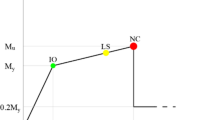Abstract
The OSS (acronym of the Italian name “Osservatorio Sismico delle Strutture”) is a network of permanent seismic monitoring systems installed in public buildings, and also in some bridges and a dam. Each system consists of a number of sensors sufficient to completely describe the dynamic behaviour of the structure. Structural typologies have been selected according to their representativeness of the public building stock and to their importance for the emergency management. Some relevant aspects are addressed, including: (i) a brief description of the network, (ii) a résumé of data usually collected and organized for each structure (structural survey and in situ tests on materials, experimental modal analysis, FEM models and structural identification) and (iii) a description of data management tools and procedures (network operation performance, post-earthquake automatic analysis, public access to data). At the end, on-going and future use of OSS data is briefly discussed, with reference to statistical analysis of relevant parameters of the available records, real-time post-earthquake damage assessment and an in-field reconnaissance visit after a recent earthquake.












Similar content being viewed by others
References
Çelebi M (2013) Seismic monitoring of structures and new developments. In Garevski M (ed) Earthquakes and health monitoring of civil structures. Springer Environmental Science and Engineering, Chapter 2, pp 37–84
Çelebi M (2014) Modern structural monitoring arrays and needs: GPS and other developments. In: Bull JW (ed) Tall buildings: design advances for construction. Saxe-coburn publications: computational science, engineering and technology vol 33, pp 143–182
Çelebi M, Huang M, Shakal A, Hooper J, Klemencic R (2013) Ambient response of a unique performance-based design tall building with dynamic response modification features. J Struct Des Tall Spec Build 8:816–829. doi:10.1002/tal.1093
Ceravolo R, De Stefano A, Matta E, Quattrone A, Zanotti Fragonara L (2013) Model updating of strategic building structures under real earthquake loading. In: Research and applications in structural engineering, mechanics and computation–Chapt. 364, CRC Press, pp 2187–2192
De Sortis A, Antonacci E, Vestroni F (2005) Dynamic identification of a masonry building using forced vibration tests. Eng Struct 27:155–165
Ewins DJ (2000) Modal testing theory practise and applications. Research Studies Press LTD, Great Britain
Fabbrocino G, Ranieri C, Laorenza C, Carluccio A, Dolce M, Manfredi G (2010) Post-earthquake experimental dynamic identification and structural assessment of a public steel building in L’Aquila. In: Proceedings of 4th international conference on steel & composite structures
Gorini A, Nicoletti M, Marsan P, Bianconi R, de Nardis R, Filippi L, Marcucci S, Palma F, Zambonelli E (2010) The Italian strong motion network. Bull Earthq Eng 8:1075–1090
Guéguen P (ed) (2013) Seismic vulnerability of structures. Wiley, Croydon
Lamonaca BG, Nicoletti M, e Spina D (2001) Permanent monitoring of the seismic response of civil structures in Italy: the Seismic Observatory of Structure Project (in Italian), Ingegneria Sismica 1/2001
Nicoletti M, Palka P, Spina D, Valente C (2001) An automatic procedure to create in real time reports on the post-earthquake state of structures monitored within the Seismic Observatory of Structures (in Italian), Atti del X Convegno Nazionale ANIDIS “L’Ingegneria Sismica in Italia”, Potenza, Italy
Peeters B, De Roek G (2001) Stochastic system identification for operational modal analysis: a review. J Dyn Syst Meas Control 123:659–667
Peeters B, Van der Auweraer H (2005) PolyMAX: a revolution in operational modal analysis. In: Proceedings of the 1st IOMAC, Copenhagen, Denmark
Picozzi M, Ditommaso R, Parolai S, Mucciarelli M, Milkereit C, Sobiesiak M, Di Giacomo D, Gallipoli MR, Pilz M, Vona M, Zschau J (2009) Real time monitoring of structures in task force missions: the example of the Mw = 6.3 Central Italy Earthquake, April 6. Natural Hazards, published online by Springer Science + Business Media BV
Ranieri C, Fabbrocino G (2014) Operational modal analysis in civil engineering structures, an introduction and guide for applications. Springer, Berlin
Rossetto T, Elnashai A (2003) Derivation of vulnerability functions for European-type RC structures based on observational data. Eng Struct 25:1241–1263
Spina D, De Angelis R, Falzone G, Gerard R, Nicoletti M, Palma F (1998) Monitoring and interpretation of the dynamic response of buildings to aftershocks during the recent seismic sequence in Umbria (in Italian), Ingegneria Sismica 1/1998
Spina D, Nicoletti M, Pizzari A, Falzone G, Gerard R, Marchioni M (2004) The earthquake of 2002 in Molise and Puglia: monitoring the dynamic response of buildings to seismic aftershocks (in Italian). Ingegneria Sismica, 1/2004, 18–25
Spina D, Lamonaca BG, Nicoletti M, Dolce M (2011) Structural monitoring by the Italian Department of Civil Protection and the case of 2009 Abruzzo seismic sequence. Bull Earthq Eng 9:325–346
Valente C, Spina D (2006) Dynamic testing and modal identification. In: Mazzolani F (ed) Seismic upgrading of RC buildings by advances techniques - The ILVA-IDEM Research Project. Polimetrica International Scientific Publisher, Milan, pp 29–101
Zambonelli E, de Nardis R, Filippi L, Nicoletti M, Dolce M (2011) Performance of the Italian Strong Motion Network during the 2009, L’Aquila seismic sequence (central Italy). Bull Earthq Eng 9:39–65
Acknowledgments
The OSS in the present stage is the result of the efforts of many people, besides the authors, during the last 16 years. In the following a non exhaustive list is reported: Roberto De Marco, Elvezio Galanti, Mauro Rosi, Giuseppe Falzone, Roberto Gerard, Marco Marchioni, Bruno Lamonaca, Renato De Angelis, Antonio Pizzari, Biagio Prezioso, Rachele Ferlito, Federico Mori, Stefano Gabriele.
Author information
Authors and Affiliations
Corresponding author
Rights and permissions
About this article
Cite this article
Dolce, M., Nicoletti, M., De Sortis, A. et al. Osservatorio sismico delle strutture: the Italian structural seismic monitoring network. Bull Earthquake Eng 15, 621–641 (2017). https://doi.org/10.1007/s10518-015-9738-x
Received:
Accepted:
Published:
Issue Date:
DOI: https://doi.org/10.1007/s10518-015-9738-x




